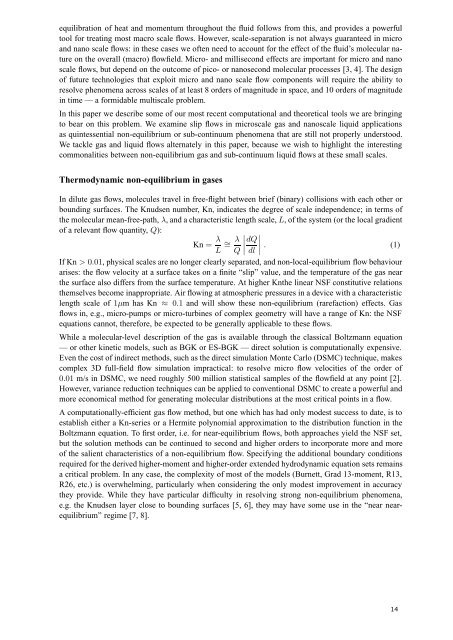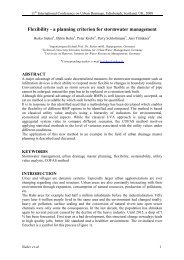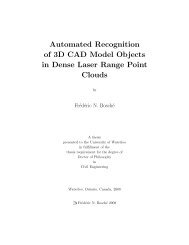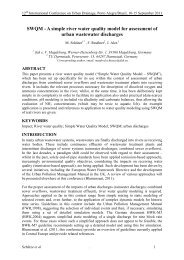ACME 2011 Proceedings of the 19 UK National Conference of the ...
ACME 2011 Proceedings of the 19 UK National Conference of the ...
ACME 2011 Proceedings of the 19 UK National Conference of the ...
You also want an ePaper? Increase the reach of your titles
YUMPU automatically turns print PDFs into web optimized ePapers that Google loves.
equilibration <strong>of</strong> heat and momentum throughout <strong>the</strong> fluid follows from this, and provides a powerful<br />
tool for treating most macro scale flows. However, scale-separation is not always guaranteed in micro<br />
and nano scale flows: in <strong>the</strong>se cases we <strong>of</strong>ten need to account for <strong>the</strong> effect <strong>of</strong> <strong>the</strong> fluid’s molecular nature<br />
on <strong>the</strong> overall (macro) flowfield. Micro- and millisecond effects are important for micro and nano<br />
scale flows, but depend on <strong>the</strong> outcome <strong>of</strong> pico- or nanosecond molecular processes [3, 4]. The design<br />
<strong>of</strong> future technologies that exploit micro and nano scale flow components will require <strong>the</strong> ability to<br />
resolve phenomena across scales <strong>of</strong> at least 8 orders <strong>of</strong> magnitude in space, and 10 orders <strong>of</strong> magnitude<br />
in time — a formidable multiscale problem.<br />
In this paper we describe some <strong>of</strong> our most recent computational and <strong>the</strong>oretical tools we are bringing<br />
to bear on this problem. We examine slip flows in microscale gas and nanoscale liquid applications<br />
as quintessential non-equilibrium or sub-continuum phenomena that are still not properly understood.<br />
We tackle gas and liquid flows alternately in this paper, because we wish to highlight <strong>the</strong> interesting<br />
commonalities between non-equilibrium gas and sub-continuum liquid flows at <strong>the</strong>se small scales.<br />
Thermodynamic non-equilibrium in gases<br />
In dilute gas flows, molecules travel in free-flight between brief (binary) collisions with each o<strong>the</strong>r or<br />
bounding surfaces. The Knudsen number, Kn, indicates <strong>the</strong> degree <strong>of</strong> scale independence; in terms <strong>of</strong><br />
<strong>the</strong> molecular mean-free-path, λ, and a characteristic length scale, L, <strong>of</strong> <strong>the</strong> system (or <strong>the</strong> local gradient<br />
<strong>of</strong> a relevant flow quantity, Q):<br />
Kn = λ<br />
L ∼ = λ<br />
� �<br />
�<br />
�<br />
dQ�<br />
�<br />
Q � dl � . (1)<br />
If Kn > 0.01, physical scales are no longer clearly separated, and non-local-equilibrium flow behaviour<br />
arises: <strong>the</strong> flow velocity at a surface takes on a finite “slip” value, and <strong>the</strong> temperature <strong>of</strong> <strong>the</strong> gas near<br />
<strong>the</strong> surface also differs from <strong>the</strong> surface temperature. At higher Kn<strong>the</strong> linear NSF constitutive relations<br />
<strong>the</strong>mselves become inappropriate. Air flowing at atmospheric pressures in a device with a characteristic<br />
length scale <strong>of</strong> 1μm has Kn ≈ 0.1 and will show <strong>the</strong>se non-equilibrium (rarefaction) effects. Gas<br />
flows in, e.g., micro-pumps or micro-turbines <strong>of</strong> complex geometry will have a range <strong>of</strong> Kn: <strong>the</strong> NSF<br />
equations cannot, <strong>the</strong>refore, be expected to be generally applicable to <strong>the</strong>se flows.<br />
While a molecular-level description <strong>of</strong> <strong>the</strong> gas is available through <strong>the</strong> classical Boltzmann equation<br />
— or o<strong>the</strong>r kinetic models, such as BGK or ES-BGK — direct solution is computationally expensive.<br />
Even <strong>the</strong> cost <strong>of</strong> indirect methods, such as <strong>the</strong> direct simulation Monte Carlo (DSMC) technique, makes<br />
complex 3D full-field flow simulation impractical: to resolve micro flow velocities <strong>of</strong> <strong>the</strong> order <strong>of</strong><br />
0.01 m/s in DSMC, we need roughly 500 million statistical samples <strong>of</strong> <strong>the</strong> flowfield at any point [2].<br />
However, variance reduction techniques can be applied to conventional DSMC to create a powerful and<br />
more economical method for generating molecular distributions at <strong>the</strong> most critical points in a flow.<br />
A computationally-efficient gas flow method, but one which has had only modest success to date, is to<br />
establish ei<strong>the</strong>r a Kn-series or a Hermite polynomial approximation to <strong>the</strong> distribution function in <strong>the</strong><br />
Boltzmann equation. To first order, i.e. for near-equilibrium flows, both approaches yield <strong>the</strong> NSF set,<br />
but <strong>the</strong> solution methods can be continued to second and higher orders to incorporate more and more<br />
<strong>of</strong> <strong>the</strong> salient characteristics <strong>of</strong> a non-equilibrium flow. Specifying <strong>the</strong> additional boundary conditions<br />
required for <strong>the</strong> derived higher-moment and higher-order extended hydrodynamic equation sets remains<br />
a critical problem. In any case, <strong>the</strong> complexity <strong>of</strong> most <strong>of</strong> <strong>the</strong> models (Burnett, Grad 13-moment, R13,<br />
R26, etc.) is overwhelming, particularly when considering <strong>the</strong> only modest improvement in accuracy<br />
<strong>the</strong>y provide. While <strong>the</strong>y have particular difficulty in resolving strong non-equilibrium phenomena,<br />
e.g. <strong>the</strong> Knudsen layer close to bounding surfaces [5, 6], <strong>the</strong>y may have some use in <strong>the</strong> “near nearequilibrium”<br />
regime [7, 8].<br />
14













